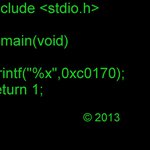mbed library sources
Dependents: Encrypted my_mbed lklk CyaSSL_DTLS_Cellular ... more
Superseded
This library was superseded by mbed-dev - https://os.mbed.com/users/mbed_official/code/mbed-dev/.
Development branch of the mbed library sources. This library is kept in synch with the latest changes from the mbed SDK and it is not guaranteed to work.
If you are looking for a stable and tested release, please import one of the official mbed library releases:
Import librarymbed
The official Mbed 2 C/C++ SDK provides the software platform and libraries to build your applications.
Diff: targets/hal/TARGET_Freescale/TARGET_KPSDK_MCUS/TARGET_KPSDK_CODE/hal/pmc/fsl_pmc_hal.h
- Revision:
- 324:406fd2029f23
- Parent:
- 149:1fb5f62b92bd
--- a/targets/hal/TARGET_Freescale/TARGET_KPSDK_MCUS/TARGET_KPSDK_CODE/hal/pmc/fsl_pmc_hal.h Mon Sep 15 15:30:06 2014 +0100
+++ b/targets/hal/TARGET_Freescale/TARGET_KPSDK_MCUS/TARGET_KPSDK_CODE/hal/pmc/fsl_pmc_hal.h Thu Sep 18 14:00:17 2014 +0100
@@ -33,6 +33,7 @@
#include <stdint.h>
#include <stdbool.h>
#include <assert.h>
+#include "fsl_device_registers.h"
#include "fsl_pmc_features.h"
/*! @addtogroup pmc_hal*/
@@ -45,19 +46,24 @@
******************************************************************************/
/*! @brief Low-Voltage Warning Voltage Select*/
-typedef enum _pmc_lvwv_select {
- kPmcLvwvLowTrip, /*!< Low trip point selected (VLVW = VLVW1)*/
- kPmcLvwvMid1Trip, /*!< Mid 1 trip point selected (VLVW = VLVW2)*/
- kPmcLvwvMid2Trip, /*!< Mid 2 trip point selected (VLVW = VLVW3)*/
- kPmcLvwvHighTrip /*!< High trip point selected (VLVW = VLVW4)*/
-} pmc_lvwv_select_t;
+typedef enum _pmc_low_volt_warn_volt_select {
+ kPmcLowVoltWarnVoltLowTrip, /*!< Low trip point selected (VLVW = VLVW1)*/
+ kPmcLowVoltWarnVoltMid1Trip, /*!< Mid 1 trip point selected (VLVW = VLVW2)*/
+ kPmcLowVoltWarnVoltMid2Trip, /*!< Mid 2 trip point selected (VLVW = VLVW3)*/
+ kPmcLowVoltWarnVoltHighTrip /*!< High trip point selected (VLVW = VLVW4)*/
+} pmc_low_volt_warn_volt_select_t;
/*! @brief Low-Voltage Detect Voltage Select*/
-typedef enum _pmc_lvdv_select {
- kPmcLvdvLowTrip, /*!< Low trip point selected (V LVD = V LVDL )*/
- kPmcLvdvHighTrip, /*!< High trip point selected (V LVD = V LVDH )*/
-} pmc_lvdv_select_t;
+typedef enum _pmc_low_volt_detect_volt_select {
+ kPmcLowVoltDetectVoltLowTrip, /*!< Low trip point selected (V LVD = V LVDL )*/
+ kPmcLowVoltDetectVoltHighTrip, /*!< High trip point selected (V LVD = V LVDH )*/
+} pmc_low_volt_detect_volt_select_t;
+/*! @brief interrupt control*/
+typedef enum _pmc_int_select {
+ kPmcIntLowVoltDetect, /*!< Low Voltage Detect Interrupt */
+ kPmcIntLowVoltWarn, /*!< Low Voltage Warning Interrupt */
+} pmc_int_select_t;
/*******************************************************************************
* API
@@ -72,57 +78,32 @@
/*!
- * @brief Low-Voltage Detect Interrupt Enable
+ * @brief Enables/Disables low voltage-related interrupts.
*
- * This function enables the interrupt for the low voltage detection. When
- * enabled, if the LVDF (Low Voltage Detect Flag) is set, a hardware interrupt
- * occurs.
+ * This function enables the interrupt for the low voltage detection, warning,
+ * etc. When enabled, if the LVDF (Low Voltage Detect Flag) is set, a hardware
+ * interrupt occurs.
*
+ * @param baseAddr Base address for current PMC instance.
+ * @param intSelect interrut select
+ * @param enable enable/disable the interrupt
*/
-static inline void pmc_hal_enable_low_voltage_detect_interrupt(void)
-{
- BW_PMC_LVDSC1_LVDIE(1);
-}
-
-/*!
- * @brief Low-Voltage Detect Interrupt Disable (use polling)
- *
- * This function disables the the interrupt for low voltage detection. When
- * disabled, an application can only check the low voltage through polling the LVDF
- * (Low Voltage Detect Flag).
- *
- */
-static inline void pmc_hal_disable_low_voltage_detect_interrupt(void)
-{
- BW_PMC_LVDSC1_LVDIE(0);
-}
+void PMC_HAL_SetLowVoltIntCmd(uint32_t baseAddr, pmc_int_select_t intSelect, bool enable);
/*!
- * @brief Low-Voltage Detect Hardware Reset Enable (write once)
+ * @brief Low-Voltage Detect Hardware Reset Enable/Disable (write once)
*
- * This function enables the hardware reset for the low voltage detection.
- * When enabled, if the LVDF (Low Voltage Detect Flag) is set, a hardware reset
- * occurs. This setting is a write-once-only; Additional writes are
- * ignored.
+ * This function enables/disables the hardware reset for the low voltage
+ * detection. When enabled, if the LVDF (Low Voltage Detect Flag) is set, a
+ * hardware reset occurs. This setting is a write-once-only. Any additional writes
+ * are ignored.
*
+ * @param baseAddr Base address for current PMC instance.
+ * @param enable enable/disable the LVD hardware reset
*/
-static inline void pmc_hal_enable_low_voltage_detect_reset(void)
+static inline void PMC_HAL_SetLowVoltDetectResetCmd(uint32_t baseAddr, bool enable)
{
- BW_PMC_LVDSC1_LVDRE(1);
-}
-
-/*!
- * @brief Low-Voltage Detect Hardware Reset Disable
- *
- * This function disables the the hardware reset for low voltage detection.
- * When disabled, if the LVDF (Low Voltage Detect Flag) is set, a hardware reset
- * does not occur. This setting is a write-once-only; Additional writes are
- * ignored.
- *
- */
-static inline void pmc_hal_disable_low_voltage_detect_reset(void)
-{
- BW_PMC_LVDSC1_LVDRE(0);
+ BW_PMC_LVDSC1_LVDRE(baseAddr, (uint8_t)enable);
}
/*!
@@ -131,80 +112,57 @@
* This function acknowledges the low voltage detection errors (write 1 to
* clear LVDF).
*
+ * @param baseAddr Base address for current PMC instance.
*/
-static inline void pmc_hal_low_voltage_detect_ack(void)
+static inline void PMC_HAL_SetLowVoltDetectAck(uint32_t baseAddr)
{
- BW_PMC_LVDSC1_LVDACK(1);
+ BW_PMC_LVDSC1_LVDACK(baseAddr, 1);
}
/*!
* @brief Low-Voltage Detect Flag Read
*
- * This function reads the current LVDF status. If it returns 1, low
+ * This function reads the current LVDF status. If it returns 1, a low
* voltage event is detected.
*
+ * @param baseAddr Base address for current PMC instance.
* @return status Current low voltage detect flag
* - true: Low-Voltage detected
* - false: Low-Voltage not detected
*/
-static inline bool pmc_hal_get_low_voltage_detect_flag(void)
+static inline bool PMC_HAL_GetLowVoltDetectFlag(uint32_t baseAddr)
{
- return BR_PMC_LVDSC1_LVDF;
+ return BR_PMC_LVDSC1_LVDF(baseAddr);
}
/*!
- * @brief Sets the Low-Voltage Detect Voltage Select
+ * @brief Sets the Low-Voltage Detect Voltage Mode
*
* This function sets the low voltage detect voltage select. It sets
* the low voltage detect trip point voltage (Vlvd). An application can select
* either a low-trip or a high-trip point. See a chip reference manual for details.
*
+ * @param baseAddr Base address for current PMC instance.
* @param select Voltage select setting defined in pmc_lvdv_select_t
*/
-static inline void pmc_hal_set_low_voltage_detect_voltage_select(pmc_lvdv_select_t select)
+static inline void PMC_HAL_SetLowVoltDetectVoltMode(uint32_t baseAddr, pmc_low_volt_detect_volt_select_t select)
{
- BW_PMC_LVDSC1_LVDV(select);
+ BW_PMC_LVDSC1_LVDV(baseAddr, select);
}
/*!
- * @brief Gets the Low-Voltage Detect Voltage Select
+ * @brief Gets the Low-Voltage Detect Voltage Mode
*
* This function gets the low voltage detect voltage select. It gets
* the low voltage detect trip point voltage (Vlvd). An application can select
* either a low-trip or a high-trip point. See a chip reference manual for details.
*
+ * @param baseAddr Base address for current PMC instance.
* @return select Current voltage select setting
*/
-static inline pmc_lvdv_select_t pmc_hal_get_low_voltage_detect_voltage_select(void)
+static inline pmc_low_volt_detect_volt_select_t PMC_HAL_GetLowVoltDetectVoltMode(uint32_t baseAddr)
{
- return (pmc_lvdv_select_t)BR_PMC_LVDSC1_LVDV;
-}
-
-
-/*!
- * @brief Low-Voltage Warning Interrupt Enable
- *
- * This function enables the interrupt for the low voltage warning
- * detection. When enabled, if the LVWF (Low Voltage Warning Flag) is set,
- * a hardware interrupt occurs.
- *
- */
-static inline void pmc_hal_enable_low_voltage_warning_interrupt(void)
-{
- BW_PMC_LVDSC2_LVWIE(1);
-}
-
-/*!
- * @brief Low-Voltage Warning Interrupt Disable (use polling)
- *
- * This function disables the interrupt for the low voltage warning
- * detection. When disabled, if the LVWF (Low Voltage Warning Flag) is set,
- * a hardware interrupt does not occur.
- *
- */
-static inline void pmc_hal_disable_low_voltage_warning_interrupt(void)
-{
- BW_PMC_LVDSC2_LVWIE(0);
+ return (pmc_low_volt_detect_volt_select_t)BR_PMC_LVDSC1_LVDV(baseAddr);
}
/*!
@@ -213,10 +171,11 @@
* This function acknowledges the low voltage warning errors (write 1 to
* clear LVWF).
*
+ * @param baseAddr Base address for current PMC instance.
*/
-static inline void pmc_hal_low_voltage_warning_ack(void)
+static inline void PMC_HAL_SetLowVoltWarnAck(uint32_t baseAddr)
{
- BW_PMC_LVDSC2_LVWACK(1);
+ BW_PMC_LVDSC2_LVWACK(baseAddr, 1);
}
/*!
@@ -226,123 +185,108 @@
* indicates a low-voltage warning event. LVWF is set when V Supply transitions
* below the trip point or after reset and V Supply is already below the V LVW.
*
+ * @param baseAddr Base address for current PMC instance.
* @return status Current LVWF status
- - true: Low-Voltage Warning Flag is set.
- - false: the Low-Voltage Warning does not happen.
+ * - true: Low-Voltage Warning Flag is set.
+ * - false: the Low-Voltage Warning does not happen.
*/
-static inline bool pmc_hal_get_low_voltage_warning_flag(void)
+static inline bool PMC_HAL_GetLowVoltWarnFlag(uint32_t baseAddr)
{
- return BR_PMC_LVDSC2_LVWF;
+ return BR_PMC_LVDSC2_LVWF(baseAddr);
}
/*!
- * @brief Sets the Low-Voltage Warning Voltage Select.
+ * @brief Sets the Low-Voltage Warning Voltage Mode.
*
* This function sets the low voltage warning voltage select. It sets
* the low voltage warning trip point voltage (Vlvw). An application can select
* either a low, mid1, mid2 and a high-trip point. See a chip reference manual for
* details and the pmc_lvwv_select_t for supported settings.
*
+ * @param baseAddr Base address for current PMC instance.
* @param select Low voltage warning select setting
*/
-static inline void pmc_hal_set_low_voltage_warning_voltage_select(pmc_lvwv_select_t select)
+static inline void PMC_HAL_SetLowVoltWarnVoltMode(uint32_t baseAddr, pmc_low_volt_warn_volt_select_t select)
{
- BW_PMC_LVDSC2_LVWV(select);
+ BW_PMC_LVDSC2_LVWV(baseAddr, select);
}
/*!
- * @brief Gets the Low-Voltage Warning Voltage Select.
+ * @brief Gets the Low-Voltage Warning Voltage Mode.
*
* This function gets the low voltage warning voltage select. It gets
* the low voltage warning trip point voltage (Vlvw). See the pmc_lvwv_select_t
* for supported settings.
*
+ * @param baseAddr Base address for current PMC instance.
* @return select Current low voltage warning select setting
*/
-static inline pmc_lvwv_select_t pmc_hal_get_low_voltage_warning_voltage_select(void)
+static inline pmc_low_volt_warn_volt_select_t PMC_HAL_GetLowVoltWarnVoltMode(uint32_t baseAddr)
{
- return (pmc_lvwv_select_t)BR_PMC_LVDSC2_LVWV;
+ return (pmc_low_volt_warn_volt_select_t)BR_PMC_LVDSC2_LVWV(baseAddr);
}
-#if FSL_FEATURE_SMC_HAS_BGEN
+#if FSL_FEATURE_PMC_HAS_BGEN
/*!
- * @brief Enables the Bandgap in VLPx Operation.
+ * @brief Enables the Bandgap in the VLPx Operation.
*
- * This function enables the bandgap in lower power modes of operation (VLPx,
- * LLS, and VLLSx). When on-chip peripherals require the bandgap voltage
- * reference in low power modes of operation, set BGEN to continue to enable
+ * This function enables/disables the bandgap in lower power modes
+ * (VLPx, * LLS, and VLLSx). When on-chip peripherals require the bandgap voltage
+ * reference in low power modes, set the BGEN to continue to enable
* the bandgap operation.
*
+ * @param baseAddr Base address for current PMC instance.
+ * @param enable enable/disable the Bangap.
*/
-static inline void pmc_hal_enable_bandgap_in_low_power_mode(void)
+static inline void PMC_HAL_SetBandgapInLowPowerModeCmd(uint32_t baseAddr, bool enable)
{
- BW_PMC_REGSC_BGEN(1);
-}
-
-/*!
- * @brief Disables the Bandgap in the VLPx Operation.
- *
- * This function disables the bandgap in lower power modes of operation (VLPx,
- * LLS, and VLLSx). When the bandgap voltage reference is not needed in low
- * power modes, disable BGEN to avoid excess power consumption.
- *
- */
-static inline void pmc_hal_disable_bandgap_in_low_power_mode(void)
-{
- BW_PMC_REGSC_BGEN(0);
+ BW_PMC_REGSC_BGEN(baseAddr, enable);
}
#endif
/*!
- * @brief Enables the Bandgap Buffer.
+ * @brief Enables/Disables the Bandgap Buffer.
*
- * This function enables the Bandgap buffer.
+ * This function enables/disables the Bandgap buffer.
*
+ * @param baseAddr Base address for current PMC instance.
+ * @param enable enable/disable the Bangap Buffer.
*/
-static inline void pmc_hal_enable_bandgap_buffer(void)
+static inline void PMC_HAL_SetBandgapBufferCmd(uint32_t baseAddr, bool enable)
{
- BW_PMC_REGSC_BGBE(1);
+ BW_PMC_REGSC_BGBE(baseAddr, enable);
}
/*!
- * @brief Disables the Bandgap Buffer.
- *
- * This function disables the Bandgap buffer.
- *
- */
-static inline void pmc_hal_disable_bandgap_buffer(void)
-{
- BW_PMC_REGSC_BGBE(0);
-}
-
-/*!
- * @brief Gets the Acknowledge Isolation.
+ * @brief Gets the acknowledge isolation value.
*
* This function reads the Acknowledge Isolation setting that indicates
* whether certain peripherals and the I/O pads are in a latched state as
* a result of having been in the VLLS mode.
*
+ * @param baseAddr Base address for current PMC instance.
* @return value ACK isolation
* 0 - Peripherals and I/O pads are in a normal run state.
* 1 - Certain peripherals and I/O pads are in an isolated and
* latched state.
*/
-static inline uint8_t pmc_hal_get_ack_isolation(void)
+static inline uint8_t PMC_HAL_GetAckIsolation(uint32_t baseAddr)
{
- return BR_PMC_REGSC_ACKISO;
+ return BR_PMC_REGSC_ACKISO(baseAddr);
}
/*!
- * @brief Clears an Acknowledge Isolation.
+ * @brief Clears an acknowledge isolation.
*
* This function clears the ACK Isolation flag. Writing one to this setting
* when it is set releases the I/O pads and certain peripherals to their normal
* run mode state.
*
+ * @param baseAddr Base address for current PMC instance.
*/
-static inline void pmc_hal_clear_ack_isolation(void)
+static inline void PMC_HAL_SetClearAckIsolation(uint32_t baseAddr)
{
- BW_PMC_REGSC_ACKISO(1);
+ BW_PMC_REGSC_ACKISO(baseAddr, 1);
}
/*!
@@ -351,14 +295,15 @@
* This function returns the regulator to a run regulation status. It provides
* the current status of the internal voltage regulator.
*
+ * @param baseAddr Base address for current PMC instance.
* @return value Regulation status
* 0 - Regulator is in a stop regulation or in transition to/from it.
* 1 - Regulator is in a run regulation.
*
*/
-static inline uint8_t pmc_hal_get_regulator_status(void)
+static inline uint8_t PMC_HAL_GetRegulatorStatus(uint32_t baseAddr)
{
- return BR_PMC_REGSC_REGONS;
+ return BR_PMC_REGSC_REGONS(baseAddr);
}
/*@}*/
 mbed official
mbed official





